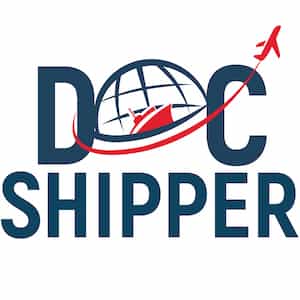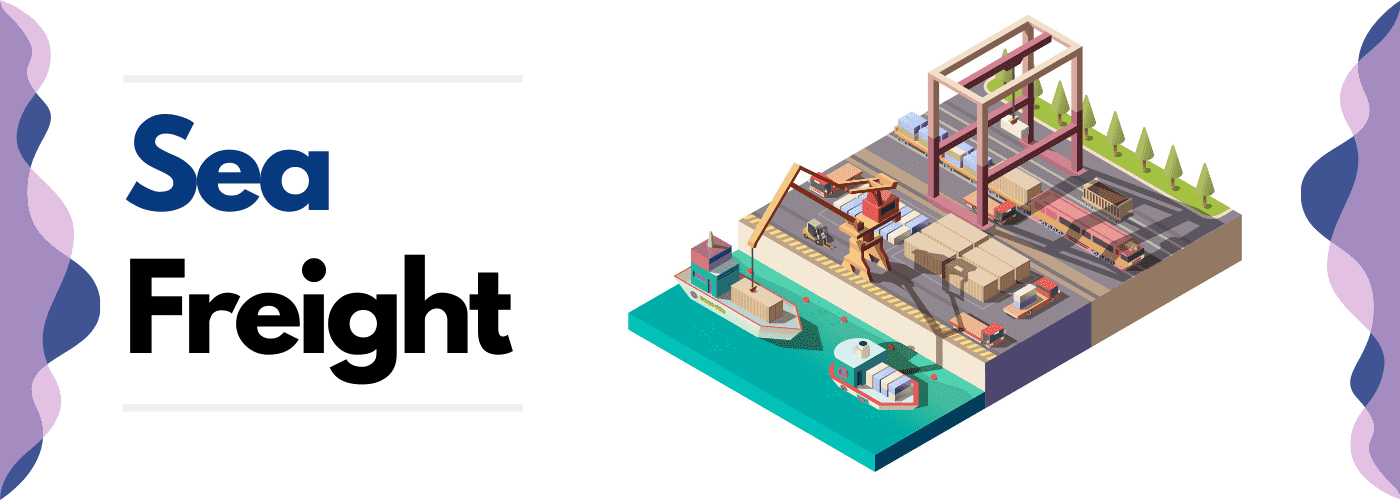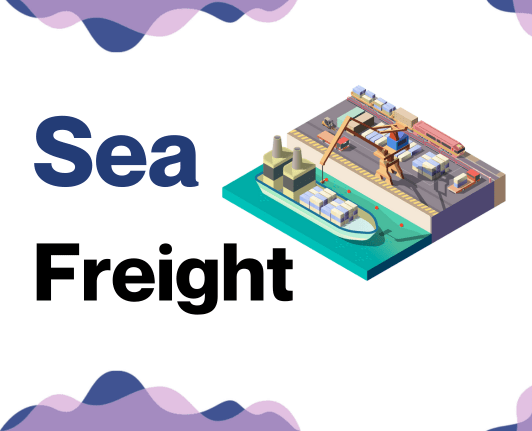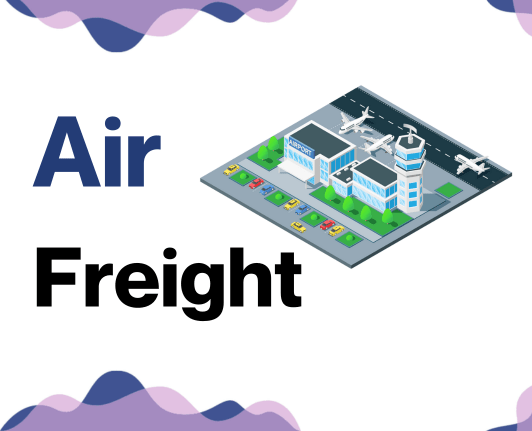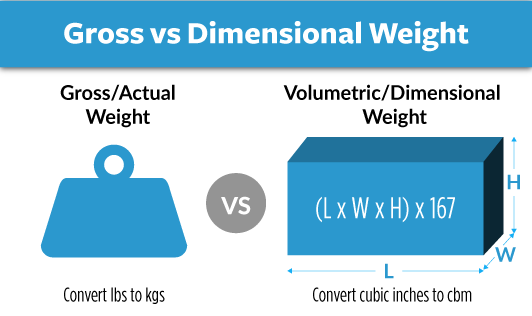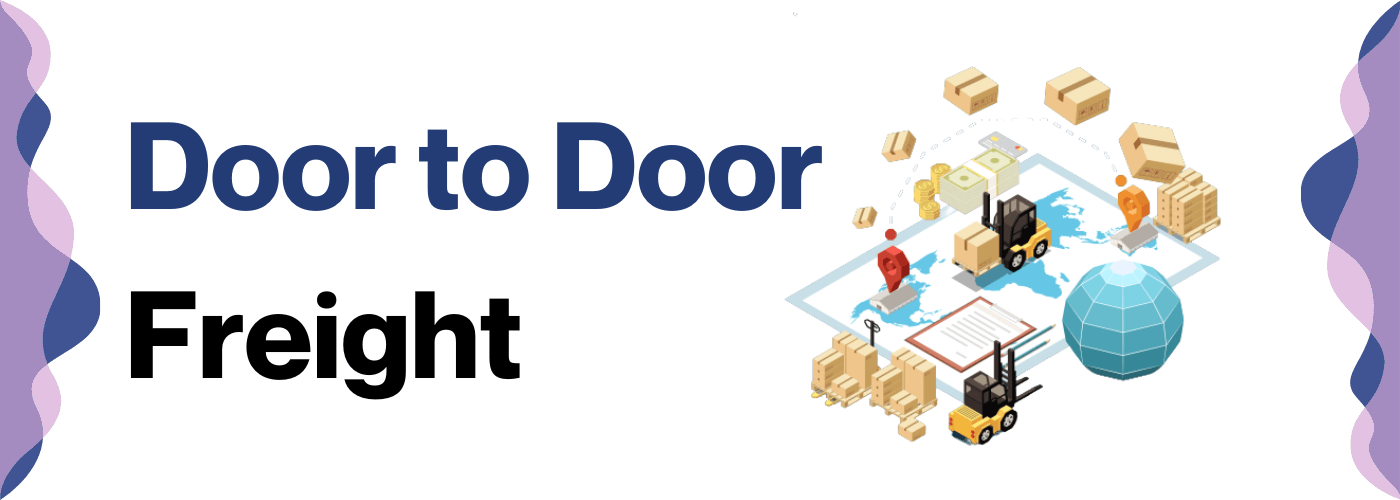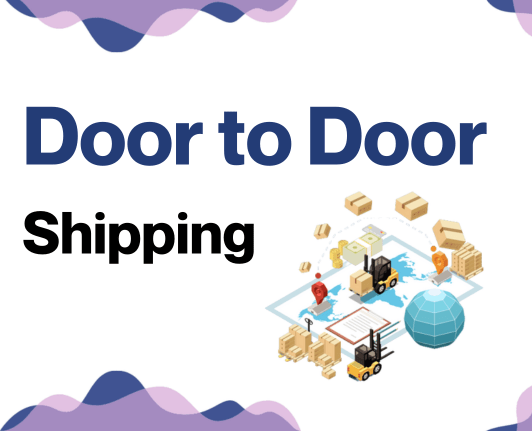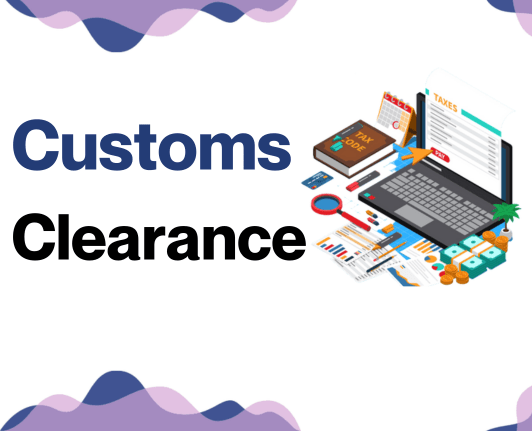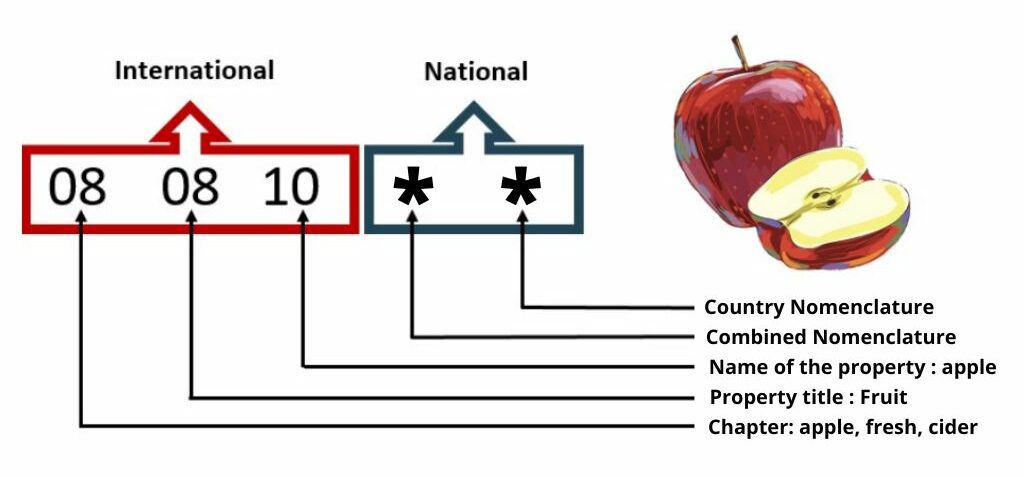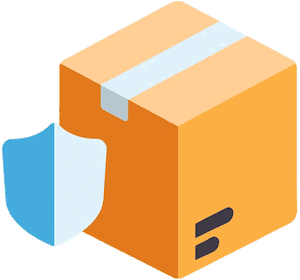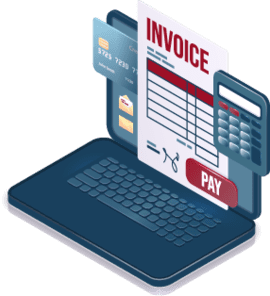Why did the package go on a vacation? To enjoy some travel time between Malaysia and Thailand, of course! Jokes aside, the complexities of freight transport between these two thriving economies can indeed make the process feel like a labyrinth, with understanding rates, transit times, and customs regulations as the main pain points. This comprehensive guide will help businesses unravel these intricacies, offering insights into various freight options, from air and sea to road and rail, alongside crucial details about customs clearance, duties, and taxes. You'll also find expert advice tailored specifically for your business needs to help you make the best shipping decisions. If the process still feels overwhelming, let DocShipper handle it for you! We turn challenges into success stories by managing every step of the shipping process, making international freight as easy as a local delivery.
Table of Contents
Which are the different modes of transportation between Malaysia and Thailand?
Deciding how to transport goods between Malaysia and Thailand can seem like a puzzle, but it doesn't have to be. Imagine you're choosing the shortest route in a board game - the goal is the same. These countries share a direct land route, making road transport a speedy and cost-effective choice. But if your business needs to ship large volumes, sea freight from port to port might be the winning path on the game board. Your strategy largely depends on what you're moving and how fast it needs to get there—just like your next game move.
How can DocShipper help?
Looking to ship goods between Malaysia and Thailand? At DocShipper, we're here for you! We understand the twists and turns of overseas logistics. From transportation to customs, administrative work to service sourcing, we handle it all. Reach out to us and bag your free estimate within the next 24 hours. Any queries? Dial up our consultants. They're always within reach, ready to assist, and the call's on the house!
DocShipper Tip: Sea freight might be the best solution for you if:
- You're dealing with hefty quantities or oversized goods. Sea transport is your go-to for maximizing space without stretching your budget.
- Time sensitivity isn't a concern for your shipment. Ocean freight is known for its leisurely pace, especially when compared to the speed of air or rail.
- Your supply chain connects key international harbors. This positions you to take full advantage of a wide-reaching network of ocean trade routes.
Sea freight between Malaysia and Thailand
Ocean shipping between Malaysia and Thailand forms an intricate web of economic activity, with vital cargo ports bridging their key industrial zones. Given the high trade volume between these Southeast Asian nations, sea freight thrives on its cost-efficiency for transporting bulk goods, albeit at a slower pace.
However, the journey is often fraught with complexities. Shippers, freight forwarders, and businesses are acquainted well with the challenges shipping between these two shores. A sea of uncertainties, tarred with the likelihood of errors, awaits, magnifying the complexity of the task. Import/export rules, unforgiving customs clearance protocols, and ambiguous documentation demand attention to detail and can be confusing. But, within this ordeal lies a silver lining — tried and tested practices and guidelines that pave the way for hassle-free shipping. By demystifying these best practices, we aim to turn the tumultuous tides into calm waters, ensuring a smooth sailing trading voyage between Malaysia and Thailand. Let's chart a course through these choppy waters together.
Main shipping ports in Malaysia
Port Klang
Location and Volume: Port Klang is located along the Strait of Malacca, just west of Kuala Lumpur. It's Malaysia's busiest port and processes around 12 million TEUs annually, making it a crucial hub for international trade.
Key Trading Partners and Strategic Importance: Its vast network includes key trading partners such as China, Singapore, the European Union, and the United States. It's strategically located on one of the world's busiest maritime trade routes.
Context for Businesses: If your business strategy involves exporting to Southeast Asia or requires transhipment services, Port Klang's high volume and wide network may prove beneficial due to its strategic location and connection to diverse markets.
Penang Port
Location and Volume: Situated at the northern part of Peninsular Malaysia, Penang Port covers all the shipping needs on the country's west coast, managing over 1.5 million TEUs annually.
Key Trading Partners and Strategic Importance: It plays a pivotal role in trade with countries such as the United States, China, and Japan. Furthermore, it's crucial to the region's electronics and electrical industry, housing many manufacturing plants nearby.
Context for Businesses: If your operations involve electronics or manufacture parts transportation, using Penang Port may streamline your logistics due to its proximity to key manufacturing hubs.
Johor Port
Location and Volume: Nestled in the southernmost part of Peninsular Malaysia, Johor Port is a multipurpose port handling 1 million TEUs annually.
Key Trading Partners and Strategic Importance: Key trade partners include ASEAN countries, the United States, and Australia. The port has strategic importance due to its proximity to the developing Malaysia–Singapore Second Link.
Context for Businesses: If your company is interested in diversifying trading partners and accessing developing infrastructure, Johor Port is a location worth considering because it provides access to a diverse and emerging market.
Tanjung Pelepas Port
Location and Volume: Located at the western end of Johor, Tanjung Pelepas Port handles nearly 8 million TEUs annually.
Key Trading Partners and Strategic Importance: The port has a strong connection with the European Union, China, and the ASEAN countries. Also, it's the second-busiest port in Malaysia.
Context for Businesses: If you aim for efficient transhipment and desire proximity to big markets like the EU and China, the Tanjung Pelepas Port could be essential for your business due to its capacity and strategic location.
Kuantan Port
Location and Volume: Livestock alongside the east coast of Peninsular Malaysia, Kuantan Port has a volume under 1 million TEUs.
Key Trading Partners and Strategic Importance: Main trading partners include China, India, Indonesia, and Singapore. Its strategic importance lies in supporting the East Coast Economic Region development, becoming a gateway to the China-ASEAN market.
Context for Businesses: If your business is investing in Asian growth markets, Kuantan Port may support your logistics strategy due to its status as a fast-growing economic hub and a prominent entry point to ASEAN markets.
Bintulu Port
Location and Volume: Positioned on the island of Borneo, Bintulu Port deals primarily with bulk and break-bulk cargo.
Key Trading Partners and Strategic Importance: It plays a significant role in the oil and gas industry, handling trade with countries including China, Japan, and Australia.
Context for Businesses: If your operation centers around oil, gas, or other bulk commodities, Bintulu Port is worth investigating for its expertise in handling such loads and its connection to key global energy markets.
Main shipping ports in Thailand
Laem Chabang port
Location and Volume: Located in the province of Chon Buri, Laem Chabang is considered the busiest and most significant port of Thailand. The port handles a shipping volume exceeding 8 million TEUs annually.
Key Trading Partners and Strategic Importance: Laem Chabang is a fundamental part of the region's economic cycle due to its connections with major ports such as Singapore, Hong Kong, and the Chinese giants of Shanghai and Shenzhen.
Context for Businesses: If your business is looking to penetrate Asian markets, then the Laem Chabang port may certainly be a vital part of your logistics strategy, thanks to its comprehensive services and direct connections with other major Asian ports.
Bangkok Port
Location and Volume: Being in the capital city of Thailand, Bangkok Port is in a strategic location aiding local import-export activities. The port handles a shipping volume of about 1.5 million TEUs per year.
Key Trading Partners and Strategic Importance: Given its central location, Bangkok Port is of significant strategic importance, facilitating trade with countries such as China, Japan, and Malaysia.
Context for Businesses: If your business is interested in efficient, direct access to Thailand's bustling capital and surrounding markets, Bangkok Port is a critical inclusion for your logistics strategy, given its central location and extensive trade network.
Map Ta Phut port
Location and Volume: Situated in the Rayong province, Map Ta Phut is one of the world's leading ports for handling bulk and liquid cargo, playing a vital role in Thailand's petrochemical industry.
Key Trading Partners and Strategic Importance: Map Ta Phut has crucial trading connections, primarily with countries involved in chemical and oil industries, including China, Japan, and South Korea.
Context for Businesses: If you're dealing in oil, petrochemicals or similar goods, Map Ta Phut might be an indispensable part of your shipping strategy, given its specialization in bulk and liquid cargo.
Sattahip port
Location and Volume: Located in the Chonburi Province, Sattahip is a sizeable Thai commercial port used for both import and export, handling an impressive percentage of Thailand's automobile shipments.
Key Trading Partners and Strategic Importance: Sattahip's principal trading partners include Japan, Singapore, and Indonesia.
Context for Businesses: If your business focuses on automobiles or heavy machinery, Sattahip might be a crucial part of your shipping strategy due to its specialization in vehicle and heavy machinery shipments.
Songkhla port
Location and Volume: Located in the southern region of Thailand, Songkhla is a key player in regional agricultural and industrial trade, with a significant volume of rubber, electronics, and agriculture shipments.
Key Trading Partners and Strategic Importance: As a gateway to Southeast Asia, Songkhla's strategic relevance can't be overstated. It primarily connects with agricultural exporting countries like Vietnam, Cambodia, and Laos, but also facilitates trade with industrial countries such as Malaysia and Singapore.
Context for Businesses: If you're looking to export or import agricultural or industrial goods in the southeast Asia region, Songkhla can be a vital repertoire in your logistics chain given its strategic location.
Ranong port
Location and Volume: The port of Ranong, also located in the southern region, offers a strategic position for trading with the coasts of Myanmar and India.
Key Trading Partners and Strategic Importance: Ranong has strong trading relationships with its neighboring country of Myanmar and other Indian Ocean economies, establishing itself as a vital juncture in these trade routes.
Context for Businesses: For businesses interested in accessing markets around the Indian Ocean, especially Myanmar and India, the Port of Ranong can play a significant part in your logistics due to its strategic location and strong trading relationships.
Should I choose FCL or LCL when shipping between Malaysia and Thailand?
Choosing between Full Container Load (FCL) and Less than Container Load (LCL), also known as consolidation? It's more than a toss-up decision! Your choice directly impacts your shipping cost, delivery timeline, and overall success between Malaysia and Thailand. This section guides you through the nuances of FCL and LCL, demystifies their differences, and enables you to execute shipments between these countries with precision and confidence. Get ready to further your understanding and make an informed, tailor-made decision for your specific shipping needs.
LCL: Less than Container Load
Definition: LCL or Less than Container Load shipment refers to when your cargo doesn't consume the full capacity of a shipping container, typically less than 15 CBM. Consolidation is an LCL freight method where multiple shipments from different shippers share a container.
When to Use: You might opt for LCL freight when shipping low-volume goods between Malaysia and Thailand, especially if they don't reach the full container volume threshold ( 13/14/15 CBM). This method offers flexibility because you're only paying for the amount of space your items take up in the container.
Example: For instance, if you're a small electronics retailer shipping a pallet of tablets, an LCL shipment would be cost-effective as your cargo will occupy a small portion of the container, and you won't need to shoulder the cost of a full container.
Cost Implications: An LCL shipping quote usually includes charges for the warehouse handling, loading, unloading, and the shared usage of the container. While this could lead to a slightly higher per-unit shipping cost in comparison to full container shipment, the total freight charges can be substantially lower if you're shipping smaller volumes of goods.
FCL: Full Container Load
Definition: FCL, or Full Container Load, is a term used in international fcl shipping meaning your cargo occupies a whole container on its own. This could be either a 20'ft container or a 40'ft container, depending on the cargo size.
When to Use: FCL is your preferred choice when your cargo volume exceeds 13/14/15 CBM. This is mainly because it's a cost-effective option for high volume shipments. Moreover, your goods remain safely sealed within the fcl container from origin to destination, minimizing the risk of damage or loss.
Example: Imagine you're a manufacturer exporting ceramics of size 18 CBM from Malaysia to Thailand monthly. Opting for FCL means your goods are transported securely, reducing the chances of your fragile items breaking during transit, and the cost per unit is also low due to the high volume of your cargo.
Cost Implications: While the initial fcl shipping quote may seem high, it's cheaper when considering the cost per unit. Specifically, the more your cargo's volume, the lower the cost per unit is. Furthermore, since the container is for your cargo alone, there's less handling of your goods, reducing potential extra costs due to damage.
Unlock hassle-free shipping
At DocShipper, we're your freight forwarding ally, making cargo shipping between Malaysia and Thailand simple and smooth. Let our ocean freight gurus guide you through your shipping options, factoring in criteria like cargo size, shipping speed, and budget. Whether it's consolidation shipping or full container loads, we will customize the solution to your business needs. Interested in an effortless shipping experience? Contact us for a free estimation.
How long does sea freight take between Malaysia and Thailand?
On average, shipping between Malaysia and Thailand by sea freight takes about 2-4 days. This transit time is estimated considering various factors such as the specific ports of loading and unloading, the nature, size and weight of the goods being shipped. Each shipment can vary, so for the most accurate estimate tailored to your unique logistics needs, contacting an experienced freight forwarder like DocShipper would be beneficial.
| From (Malaysia) | To (Thailand) | Average Transit Time (days) |
| Port Klang | Port of Laem Chabang | 3 |
| Port Klang | Port of Bangkok | 4 |
| Port of Tanjung Pelepas | Port of Laem Chabang | 3 |
| Port of Tanjung Pelepas | Port of Bangkok | 4 |
How much does it cost to ship a container between Malaysia and Thailand?
Unpacking the cost to ship a container between Malaysia and Thailand can feel like delving into a labyrinth. Firstly, it's crucial to understand that ocean freight rates, or any mode of transportation, extend broadly. For instance, the shipping cost may hover in a wide range - a ballpark estimate, given the many variables in play. Variables such as Point of Loading, Point of Destination, the carrier used, the nature of goods, and even monthly market fluctuations. Due to these elements, offering an exact price straightaway isn't feasible. But fear not, our seasoned shipping specialists are on-hand to dig into the details. They'll consult with you, crafting a quote that leaves no stone unturned and ensures the best rates tailored to your unique shipping situation.
Special transportation services
Out of Gauge (OOG) Container
Definition: Out of Gauge (or OOG) container is a shipping option specifically designed to accommodate oversized cargo that doesn’t fit into standard containers.
Suitable for: Enormous items, heavy machinery, large industrial equipment, or infrastructure components.
Examples: You might use an OOG container if you’re shipping something like industrial construction equipment, large turbines, or generators from Malaysia to Thailand.
Why it might be the best choice for you: If you're dealing with extremely large and weighty items, your out of gauge cargo will be well-protected in OOG containers and can comfortably sail across the sea without damage, assuring safe arrival at the destination.
Break Bulk
Definition: Break bulk refers to shipping goods that are not contained within trailers or containers and are usually loaded individually onto a vessel.
Suitable for: Different types of cargo that can't be shipped in containers due to their size or shape.
Examples: Wind turbine blades, industrial pumps, large cables, and heavy machinery are often shipped as break bulk.
Why it might be the best choice for you: If you’re navigating the logistics of individually large or heavy items, break bulk is the way to go, as it provides greater flexibility in managing loose cargo load.
Dry Bulk
Definition: Dry bulk shipping is the transportation method used for cargoes that are poured and can flow freely, like sand, grains or minerals.
Suitable for: Raw material shipments like coal, cement, grains, or sugar.
Examples: Perfect for businesses that need sea freight shipping for commodities like rice or rubber from Malaysia to Thailand.
Why it might be the best choice for you: If your business operation includes the shipment of free-flowing raw materials, dry bulk is a cost-effective and efficient solution.
Roll-on/Roll-off (Ro-Ro)
Definition: Roll-on/Roll-off, or Ro-Ro, refers to vessels designed to carry wheeled cargo like cars, trucks, and trailers that are driven on and off the vessel on their own wheels.
Suitable for: Large wheeled machinery, motorbikes, cars, buses, trucks.
Examples: An automotive manufacturer looking to transport cars or heavy machinery from Malaysia to Thailand.
Why it might be the best choice for you: If your cargo is motorized and can be easily driven onto a ro-ro vessel, this would be an efficient and safe shipping mode.
Reefer Containers
Definition: Reefer containers are refrigerated containers designed for transporting perishable goods that require a temperature-controlled environment.
Suitable for: Perishable goods, temperature-sensitive pharmaceutical products, certain chemicals.
Examples: Seafood, fruits, vegetables, and meats are prime examples of goods suitable for Reefer shipping.
Why it might be the best choice for you: If you are in the business of transporting goods that require specific temperature conditions, reefer containers offer a controlled environment to keep your cargo in an optimal state from pick-up to delivery.
Whatever your shipping needs may be, whether it’s OOG, break bulk, dry bulk, Ro-Ro, or reefer, DocShipper is ready to assist with your sea freight between Malaysia and Thailand. Contact us for a free shipping quote in less than 24 hours.
DocShipper Tip: Air freight might be the best solution for you if:
- You're pressed for time or facing a non-negotiable deadline. Air freight delivers unparalleled speed when it comes to transit times.
- Your shipment is modest in size, falling under 2 CBM. Air freight is particularly well-suited for these smaller consignments.
- Your supply chain includes destinations that are off the beaten maritime or rail paths. Air freight gives you access to a comprehensive global airport network.
Air freight between Malaysia and Thailand
In the fast-paced sphere of international trade, air freight between Malaysia and Thailand is a game-changer. It offers speed and reliability that's hard to match, not to mention the cost-effectiveness when handling small, high-value items. Imagine moving the latest smartphones or crucial pharmaceuticals: air freight stands out.
However, choosing to ship by air isn't a matter of flipping a coin; it's a calculated decision fraught with complexities. For instance, incorrectly estimating your goods' weight can inflate shipping costs dramatically. Is it simply the gross weight, or is volumetric weight the key? Missteps like these act like hidden quicksand in your shipping journey, costing you time and money. Uncovering these best practices, we aim to transform unnecessary losses into smart savings for you.
Air Cargo vs Express Air Freight: How should I ship?
Baffled about choosing between air cargo and express air freight for your shipment from Malaysia to Thailand? Relax, we've got you covered. Think of air cargo as your stuff taking a shared ride on a commercial airline, while express air freight is basically your goods jetting off on a private flight. Cut through the clutter with this guide as we break it all down for you, weighing up the pros and cons of each option. Let's dive right in.
Should I choose Air Cargo between Malaysia and Thailand?
Opting for air cargo between Malaysia and Thailand can offer reliability and substantial cost benefits, especially as your consignment exceeds 100/150 kg. Airlines like Malaysian Airlines and Thai Airways, leading players in this space, sustain regular freight schedules. Although transit times could be longer due to fixed schedules, they ensure disciplined service delivery. So, if budgetary efficiency is a priority, air freight can be an attractive bet. Dedicate time evaluating your shipping needs, and it might reveal this to be your ideal transport mode. Remember, every kilogram counts!
Should I choose Express Air Freight between Malaysia and Thailand?
Express Air Freight, a unique service utilizing dedicated cargo planes, is potentially your best solution for shipping cargo under 1 CBM or around 100/150 kg. Unlike the standard air-freight process, this option caters solely to cargo, permitting quicker transit times. Renowned couriers such as FedEx, UPS, and DHL provide this service, each ensuring rapid and secure delivery. Opting for this choice will serve you best if your shipment needs to reach Thailand from Malaysia in the least amount of time, typically within a couple of days. This option is ideal for light-weight, urgent, or high-value items. Choose wisely, as your decision could significantly impact delivery speed and cost.
Main international airports in Malaysia
Kuala Lumpur International Airport
Cargo Volume: Approximately 726,230 metric tonnes per year.
Key Trading Partners: China, USA, Singapore, Japan, and India.
Strategic Importance: Situated in the heart of South East Asia, Kuala Lumpur International Airport serves as a crucial gateway for freight transport throughout the region.
Notable Features: KLIA has advanced cargo facilities and can handle large amounts of diverse cargo, including perishables, dangerous goods, and valuable items.
For Your Business: KLIA's advanced facilities and strategic location could prove instrumental in your business's shipping operations, significantly reducing transit time and costs.
Penang International Airport
Cargo Volume: Approximately 169,000 metric tonnes per year.
Key Trading Partners: USA, Singapore, Japan, Hong Kong, and Germany.
Strategic Importance: Known as Malaysia's Silicon Valley, the region has major electronics and manufacturing industries. The airport is vital for these speed-and-time sensitive cargo shipments.
Notable Features: Features include temperature-controlled areas suitable for sensitive electronics and pharmaceutical goods.
For Your Business: If your company specializes in electronics or pharmaceutical goods, Penang International Airport's specialized facilities can ensure your goods arrive safely and in the best condition.
Sultan Abdul Aziz Shah Airport
Cargo Volume: Unspecified, but its freight forwarding facilities are designed for speedy cargo handling.
Key Trading Partners: Majorly local businesses in Selangor and its environs.
Strategic Importance: Being located in Subang, Selangor, it provides easy and fast access to one of Malaysia's most populated and industrialized states.
Notable Features: Provides cold storage for perishables and pharmaceuticals, and has a bonded warehouse for holding international cargo.
For Your Business: If your business relies heavily on time efficiency, consider this airport due to its well-oiled logistics and close proximity to many manufacturing centers.
Senai International Airport
Cargo Volume: Approximately 10,000 metric tonnes per year.
Key Trading Partners: Singapore, China, Japan, and Indonesia.
Strategic Importance: Located in the southern economic region, it is a key player in Malaysia's logistics ecosystem serving a region famed for its oil palm, rubber and petroleum industries.
Notable Features: Offering ample warehouse space and a range of cargo handling capabilities, it supports many industries.
For Your Business: If you're dealing with oversized or project cargo, consider Senai International Airport due to its ample cargo space, warehouse facilities, and strategic location near key industries.
Kuching International Airport
Cargo Volume: Approximately 23,000 metric tonnes per year.
Key Trading Partners: Singapore, Indonesia, Brunei, and China.
Strategic Importance: Key airport in the Malaysian Borneo region, promoting development in this largely agricultural sector.
Notable Features: Provides dedicated cargo facilities, including cold storage for perishables, which are key exports in the region.
For Your Business: For businesses trading in agricultural commodities and seeking access to Borneo and its environs, Kuching International Airport's cargo facilities and strategic location could be crucial in your shipping strategy.
Main international airports in Thailand
Suvarnabhumi Airport
Cargo Volume: Suvarnabhumi Airport handles more than 1.3 million tons of cargo annually, making it a significant logistics hub in Southeast Asia.
Key Trading Partners: It has strong cargo links with China, Japan, and the United States, amongst others.
Strategic Importance: As Thailand's largest airport, it plays a pivotal role in connecting the country with international markets and is the main base for Thai Airways.
Notable Features: The airport boasts state-of-the-art facilities, including an extensive free-trade zone with storage, packaging, and transport logistics services.
For Your Business: If you need to quickly move high volumes of goods, particularly electronics or automotive components, this hub's efficient operations and wide reach make it an excellent choice.
Don Mueang International Airport
Cargo Volume: This airport handles over 18,000 tons of cargo each year.
Key Trading Partners: Important trading partners include China, Taiwan, and the neighboring countries of ASEAN.
Strategic Importance: As Thailand's second busiest airport, it services many low-cost carriers, providing an economical shipping option.
Notable Features: Known for its mixed-use operations, Don Mueang supports both passenger and cargo flights.
For Your Business: If you're seeking a cost-efficient gateway for smaller cargo batches, Don Mueang's vast network of affordable airlines makes it a feasible choice.
Phuket International Airport
Cargo Volume: Phuket International handles approximately 76,000 tons of cargo annually.
Key Trading Partners: The airport's primary trading partners include Malaysia, China, and Russia.
Strategic Importance: Located in a major tourist destination, this airport has a strong network of international flights.
Notable Features: It is distinguished by its capacity to operate direct flights worldwide, reducing shipping times.
For Your Business: If you are trading in consumer goods or perishable items, Phuket International's fast connections and direct flights can ensure your cargo reaches its destination swiftly.
Chiang Mai International Airport
Cargo Volume: Handling about 16,000 tons of cargo annually, Chiang Mai International Airport serves as a significant northern gateway.
Key Trading Partners: Strong cargo relations exist with China, Singapore, and Laos, among others.
Strategic Importance: The airport connects Thailand's northern regions with international markets, further enabling economic development in the area.
Notable Features: The airport houses a Free Zone providing storage and other logistical support.
For Your Business: If your shipping needs relate to North Thailand's industries, such as agricultural exports or handicrafts, this airport's regional connectivity could prove beneficial.
U-Tapao Rayong-Pattaya International Airport
Cargo Volume: U-Tapao Rayong-Pattaya International moves close to 12,000 tons of cargo per year.
Key Trading Partners: Key trade relations exist predominantly with Asian nations such as Vietnam, China, and Japan.
Strategic Importance: Located near the Eastern Economic Corridor, it plays a crucial role in the shipment of goods within Asia.
Notable Features: The airport offers an air cargo village for better logistics management and a Free Zone for cargo operations.
For Your Business: If your business trades heavily within Asia, U-Tapao's strategic placement and dedicated cargo village serve as a promising avenue for efficient intra-Asia logistics.
How long does air freight take between Malaysia and Thailand?
On average, air freight from Malaysia to Thailand takes 1-2 days. However, specific transit times can vary depending on a host of factors including, notably, the departure and arrival airports, the weight of the cargo, and the nature of the goods being transported. For more precise timelines tailored to your shipping needs, it's recommended to reach out to a dedicated freight forwarder such as DocShipper.
How much does it cost to ship a parcel between Malaysia and Thailand with air freight?
Shipping an air freight parcel between Malaysia and Thailand can cost between $1.50 and $4.00 per kilogram, on average. However, this is a broad estimate. The exact cost is influenced by a number of factors, including the distance from the departure and arrival airports, the parcel's dimensions and weight, the nature of the goods, and more. Rest assured, our experienced team will be more than willing to work with you, providing the best customized rates based on your unique shipping requirements. Waiting on high shipping quotes becomes a thing of the past with us - reach out for a free quote delivered to your inbox in less than 24 hours!
What is the difference between volumetric and gross weight?
Gross weight refers to the actual weight of a shipment, inclusive of all packaging and the pallet it's shipped on. Volumetric weight, on the other hand, is a pseudo-weight derived from the space that the shipment occupies in the aircraft.
To figure out the gross weight of a shipment using air cargo, you just weigh your package with all its contents, packaging, and pallet (if any). Imagine that you have a crate that weighs 100 kg (or 220 lbs if you use the imperial system).
For volumetric weight, you calculate it by multiplying the length, width, and height of your package, then dividing it by a standard factor. In air cargo, this factor is typically 6,000. So, say that crate of yours is 1.2m in length, 0.8m in width, and 1m in height, your volumetric weight would be (1.2m 0.8m 1m) / 6,000, which equals 160kg (or around 352 lbs). But for Express Air Freight, the dividing factor is often smaller, at 5,000. Using the same crate dimensions, the volumetric weight will be now 192 kg (or 423 lbs).
Freight charges essentially come down to efficiency: the more space your shipment takes up relative to its weight, the more you pay. This is why freight is charged based on whichever is higher, the gross weight or the volumetric weight.
DocShipper tip: Door to Door might be the best solution for you if:
- You value convenience and want a seamless shipping process, as door-to-door takes care of every step from pickup to delivery.
- You prefer a single point of contact, as door-to-door services typically provide a dedicated agent to handle all aspects of the shipment.
- You want to minimize the handling of your goods, reducing the risk of damage or loss, as door-to-door minimizes transitions between different modes of transport.
Door to door between Malaysia and Thailand
Door to Door shipping, an end-to-end international service in which your goods are picked up, transported, and delivered straight to the desired location, makes logistics hassle-free. In the Malaysia-Thailand corridor, this method boasts clear advantages like speed and accountability that optimize your supply chain. So, why wait? Let's dive into the ins and outs of Door to Door shipping between these neighboring nations.
Overview – Door to Door
Overwhelmed by the complexities of shipping between Malaysia and Thailand? Consider door to door as your stress-free logistics solution. As your trusted partner, we streamline every aspect, from customs clearance to last-mile delivery, making it an attractive choice for many of our clients at DocShipper. While it's undoubtedly convenient, it might be pricier than the alternatives. But remember, the convenience and simplicity of this one-stop-shop solution allows you to focus on your core business operations. It's the epitome of 'effortless shipping' and a boon for your peace of mind.
Why should I use a Door to Door service between Malaysia and Thailand?
Hey, fancy letting someone else deal with the pressure of logistics? Here's why you should opt for a Door to Door service when shipping from Malaysia to Thailand.
1. Stress-Free Logistics: Imagine not having to worry about arranging different legs of the shipment, customs clearance or local transportation. With Door to Door service, the entire freight is handled by one provider – that's peace of mind in one neat package!
2. Timely Delivery: Have an urgent shipment and no time to micro-manage? Trust Door to Door service! They understand the importance of time-sensitive delivery, ensuring your cargo arrives exactly when it should.
3. Specialized Care for Complex Cargo: If your freight requires special handling or runs the risk of damage during transfers, Door to Door service is a lifesaver. One provider means less room for error – they're pros at this!
4. End-to-End Convenience: From careful pickup to safe final delivery, you're covered. No need to arrange for local trucking at your destination. The carrier takes care of it all, making it a breeze for you.
5. Single Point of Responsibility: Uncertainty about whom to contact within multiple service providers can be a mess. With Door to Door services, you know exactly who’s accountable for your cargo from start to finish.
Who needs the extra dose of logistical tension? Sit back, choose Door to Door service, and - in the famous words of a certain movie - Keep calm and carry on!
DocShipper – Door to Door specialist between Malaysia and Thailand
Unwind while DocShipper manages the intricate task of door-to-door shipping between Malaysia and Thailand. With our comprehensive service, there's no need for you to shoulder the worrying responsibility - we have you covered from packing to customs clearance across all modes of transport. Our adept team, coupled with your dedicated Account Executive, ensures smooth sailing. Reach out for a no-obligation estimate within 24 hours, or avail free consultation from our experts.
Customs clearance in Thailand for goods imported from Malaysia
Customs clearance is an essential, often tricky stage in moving goods between countries, and Thailand is no exception. Navigating this process to import goods from Malaysia can present unexpected hurdles like hidden fees and sudden charges. Crucially, regulations such as duties, taxes, quotas, and licenses not only influence costs but can dictate if your shipment even makes it past Thai customs. Got your head spinning? Don't worry; we'll dive into all these areas deeply. Count on DocShipper to guide you through the maze, ensuring smooth, hassle-free transfers for any type of goods, wherever they’re from. To kickstart the process and get an estimate, just hit us up with the origin, value, and HS Code of your goods. Then, leave the rest to us!
How to calculate duties & taxes when importing from Malaysia to Thailand?
Understanding the complexity of import duties and taxes is critical when shipping goods from Malaysia to Thailand. The calculation hinges on a number of factors such as the country of origin, the Harmonised System Code (HS Code), the Customs Value, and the Applicable Tariff Rate. On top of these, you'll also need to account for any additional taxes or fees that may apply to your specific products.
Initiating the process starts with pinpointing the exact country where the goods you're shipping were originally manufactured or produced. This seemingly straightforward first step plays a fundamental role in determining how much you'll eventually need to pay in duties and taxes. By getting these details right from the get-go, you're paving the way to a smoother, more predictable Customs clearance process.
Step 1 - Identify the Country of Origin
Understanding your item's country of origin isn't just a routine step; it sets the stage for smooth customs clearance.
Firstly, it's pivotal in ascertaining the HS Code which effectively determines your tax bracket. Secondly, it's instrumental in exposing you to benefits conferred by trade agreements. The ASEAN Free Trade Area (AFTA), for instance, can significantly reduce or eliminate your customs duties when importing from Malaysia to Thailand.
Thirdly, correctly identifying the source location helps you navigate restrictions like the Thai government's limitation on certain Malaysian exports. Fourthly, it's an absolute requirement for all import documentation – essential for avoiding clearance hiccups. Finally, it aids in product labelling; a necessity if you plan to sell your goods openly in Thailand.
Being well-versed in these nuances empowers you to strategically plan your importing process. So, appreciate the weight of this 'seemingly obvious' step, embrace it, and watch as it clears your path towards import success.
Step 2 - Find the HS Code of your product
The Harmonized System (HS) code is a standardized system of names and numbers to classify traded products. These codes are used by customs authorities around the world to identify products and apply tariffs. The HS code for a specific product is crucial when preparing shipping documents, ensuring the correct duties and taxes are applied, and avoiding delays in customs.
Your supplier should typically be able to provide the HS code for your product as they are often familiar with import regulations. However, if that isn't an option, don't worry. We have a simple, step-by-step process to help you identify the correct code.
First, navigate to the Harmonized Tariff Schedule. Use the search bar to look up your product by name, then scan the Heading/Subheading column to find the corresponding HS code.
Note of Caution: It's absolutely essential to accurately identify your product's HS code. An incorrect code can result in customs delays and potential fines due to incorrect customs declarations.
To help you understand these codes further, here's an infographic showing you how to read an HS code.
Step 3 - Calculate the Customs Value
Understanding the concept of 'customs value' can feel cascading, but it's a crucial part of your import process. It isn't the exact price of your goods. Instead, it's the CIF value, a term that might rumble a question. CIF refers to Cost, Insurance, and Freight. So, your customs value is the cost of your products, plus the insurance, plus the cost of international shipping.
Confused? Let's break it down with an example. Jeffrey’s Toy Company imports $10,000 worth of toys from Malaysia. He paid $1000 for shipping and $200 for insurance. His CIF value equals $11,200. That's the figure Thai Customs uses to calculate any import duties. Knowledge of how this works gives Jeffrey, and you, a clearer picture of potential costs, keeping unpleasant surprises at bay! Who knew customs calculations could be kid's play?
Step 4 - Figure out the applicable Import Tariff
Import tariffs, otherwise known as customs duties, represent a crucial aspect of international shipping. These are taxes levied on goods entering a country, and they vary based on the type and origin of the product. In Thailand, the most common type of tariff used is the Harmonized System (HS) code tariff.
Finding the applicable import tariff for a product from Malaysia involves the following steps:
1. Identify the HS code for your product. For example, if you're shipping headphones, the HS code would be 8518.30.
2. Visit the Thailand Customs Department website or use an online global database service for tariff information. Enter the HS code and the country of origin (Malaysia).
3. Review the corresponding tariff rates. For example, headphones from Malaysia may have a tariff rate of 20%.
To calculate the import duty, consider the cost, insurance, and freight (CIF) value. For instance, if the CIF value of the headphones shipment is $10,000, the import duty payable would be $10,000 20% = $2,000.
By understanding the associated tariffs and how they're calculated, you can anticipate costs and make informed shipping decisions to ensure a seamless transition for your goods across borders.
Step 5 - Consider other Import Duties and Taxes
In the world of international trade, standard tariff rates barely scrape the surface of your tax responsibilities. For instance, goods imported from Malaysia to Thailand may be subjected to additional duties subject to their nature and origin.
Let's delve into these further costs. Excise duty is applied selectively depending on the product classifications, such as tobacco or motor vehicles. If a product's price seems suspiciously low, anti-dumping taxes may come into play to prevent businesses from selling their goods below market value.
The gold medalist of them all, Value Added Tax (VAT), typically accounts for a significant portion of your total import cost. As of now, Thailand's VAT stands at 7%. Here's a simple formula to give you an idea of how it's calculated: Cost, Insurance, and Freight (CIF) value + all other duties and taxes x VAT rate (%) = VAT
For example, let's say you're importing goods with a CIF value of $1000, and the overall duties amount to $200, you can estimate your VAT as ($1000+$200) x 7/100 = $84. Keep in mind, these are hypothetical rates.
Unforeseen taxes can be an unwelcome surprise, so having good grasp of these can save you from overspending and help streamline your import processes.
Step 6 - Calculate the Customs Duties
Customs duties calculation may seem complex, yet gaining a basic understanding puts you in command of your shipping costs. Imagine this: You’re shipping plastic toys costing $2000 (customs value) from Malaysia. Your customs duties in Thailand would depend solely on your product’s Harmonized System (HS) code. Let’s assume it’s 15%. Hence, you pay $300.
Now let’s navigate to a scenario where there are customs duties and VAT. Shipping kitchen appliances valued at $3500? Remember, Thailand has a standard VAT rate of 7%. Your customs duties ($525 with HS rate 15%) and VAT ($282 calculated on customs value + customs duty) join in to total $807.
But what happens when anti-dumping taxes & excise duty get involved? Shipping expensive leather jackets costing $5000? With a customs rate of 20%($1000), VAT of 7%($392 on customs value + customs duty), a hypothetical anti-dumping tax of 10%($500), and Excise Duty 1%($55 on customs value + customs duty + VAT), your total bill hits $1947.
Of course, these calculations can baffle the best of us. That's where DocShipper comes in, simplifying this tangled web of computations. Operating globally, we can handle every step of your customs clearance, even ensuring that you're never charged more than what's due. Interested in hassle-free, affordable services and a free quote in less than 24h? Reach out to DocShipper today!
Does DocShipper charge customs fees?
While DocShipper, as a custom broker in Malaysia and Thailand, plays an essential role in your import/export process, we don't charge customs duties. Those are government fees, with the evidence provided through official documents. Our role is securing customs clearance, so expect to pay clearance fees, giving you peace of mind for otherwise complex legal processes. For instance, think of shipping electronics to Thailand, where various regulations apply. We handle paperwork, ensuring compliance, while duties incurred are solely from government tariffs. In essence, our fees cover service, while customs duties are a governmental matter.
Contact Details for Customs Authorities
Malaysia Customs
Official name: Royal Malaysian Customs Department
Official website: http://www.customs.gov.my/en/
Thailand Customs
Official name: The Customs Department, Ministry of Finance, Thailand.
Official website: http://en.customs.go.th/
Required documents for customs clearance
Stumped by the paperwork jungle of your shipping endeavors? We've got your back! Dive into our rundown on key documents - Bill of Lading, Packing List, Certificate of Origin, and Conformity Documents (CE Standard). We'll help conquer those customs clearance hurdles, each form at a time. Let's blast those red-tape blues away!
Bill of Lading
Embarking on a shipping journey from Malaysia to Thailand? A Bill of Lading (BoL) will be your best ally. This isn't just a document; it's your proof of ownership, a transfer pass for your goods. Think of it as the equivalent of a courier's delivery slip, but on an international scale. Opting for an electronic ('telex') version can streamline your shipping like a breeze. No worries about lost paperwork or delays, plus it's eco-friendly. And did you know? For air cargo, an Air Waybill (AWB) serves the same purpose. Keep these in your arsenal to ensure a smooth transition of your goods, paving the way for a hassle-free customs clearance experience. Shipping has never been easier!
Packing List
When shipping goods from Malaysia to Thailand, your Packing List proves vital. Just like an inventory of your luggage before an airport trip, the Packing List is an accurate record of what's in your shipment. It's your job as the shipper to make sure this document is up-to-date and accurate. Picture this: your shipment of handcrafted furniture gets held up because your Packing List doesn't match the contents your freight forwarder finds! It's a nightmare scenario that can be avoided with a detailed and correct Packing List. So whether you're sending cargo by sea or air, keep in mind - accuracy in your Packing List isn't just advisable, it's a necessity. Let's avoid any unnecessary delays and get your goods from Malaysia to Thailand seamlessly.
Commercial Invoice
When shipping goods from Malaysia to Thailand, your Commercial Invoice plays a pivotal role in customs clearance. It details your transaction and proves the import value of the goods - specifics that's indispensable to customs authorities. To ace the process, ensure it bears crucial data - product descriptions, terms of delivery, and the item's Harmonized System (HS) code. More specifically, if you're dispatching automotive parts, precise descriptions such as Aluminium Radiator, HS code 870891 thwart clearance hiccups.
Remember, consistency across documentation is key. Details on your invoice should align scrupulously with those on your Bill of Lading or Air Waybill. Nailing this can propel stress-free clearance and sidestep potential delays or penalties – a win for your shipping timeline and budget. Again, precision and accuracy on your Commercial Invoice not only repel roadblocks but can smoothen your shipping experience from Malaysia to Thailand.
Certificate of Origin
Shipping goods between Malaysia and Thailand? A crucial document you need is the Certificate of Origin. It verifies your goods' manufacturing country, a key factor in determining customs duties. Say you're shipping handmade batik textiles from Malaysia, including a Certificate of Origin can unlock preferential duties, potentially saving your business money. Keep in mind, transparency about your goods' origin isn't just commendable—it's mandatory. Incorrect or missing information can result in shipping delays or penalties. So, whether you're sending Selangor pewters or Penang's finest spices, the Certificate of Origin underpins your cross-border trade success.
Get Started with DocShipper
Experience seamless shipping between Malaysia and Thailand with DocShipper! We understand how grueling and complex customs clearance can be. That's why our team is devoted to managing every step for you, ensuring your consignments pass through swiftly and safely. Why grapple with the paperwork? Let us do the hard work! Contact us today and receive a free quote within 24 hours. Make your international shipping worry-free with DocShipper.
Prohibited and Restricted items when importing into Thailand
Understanding what you can and cannot ship into Thailand can be tricky, with potential missteps causing delivery delays and financial penalties. We'll take you through an essential list of prohibited and restricted goods to help you avoid any customs hiccups. Don't let overlooked regulations stall your business. Let's dive right in.
Restricted Products
- Medicine and Pharmaceuticals: You'll need to secure an import license from the Food and Drug Administration Thailand (FDA)
- Pets and Animals: A permit from the Department of Livestock Development Thailand here.
- Plants and Agrarian Products: Special permits can be obtained from the Department of Agriculture Thailand .
- Vehicle Parts: You have to apply for an import license from the Ministry of Commerce Thailand .
- Radioactive Substances: For this category, you have to acquire a license from the Office of Atoms for Peace.
- Cultural Items: This category requires a permit from the Ministry of Culture Thailand .
- Tobacco products: For these type of products, you have to secure an import and excise license from the Excise Department .
Remember, each category listed here may have additional requirements and it's critical to contact the relevant department for full details.
Prohibited products
- Narcotics: All drugs classified as narcotics, including heroin, cocaine, amphetamines, and hallucinogenic mushrooms, are strictly prohibited.
- Obscene materials: This includes any material deemed offensive, inappropriate, or pornographic in nature.
- Counterfeit goods: Any imitation or replica items that infringe on intellectual property or trademark rights are illegal.
- Endangered species and by-products: Trade in animals, plants, and their by-products, protected by the Convention on International Trade in Endangered Species of Wild Fauna and Flora (CITES) is prohibited.
- Firearms and ammunition: Importation of all types of guns and ammunition is strictly controlled and generally prohibited without prior approval.
- Counterfeit and altered currency: Importation of counterfeit money or any form of altered currency is strictly forbidden.
- Radioactive substances: This covers all materials and substances that are radioactive.
- Specific agricultural products: Some types of fruits, vegetables, and plant materials are banned to prevent the spread of diseases and pests.
- Goods with Thai national flag: Items bearing the Thai national flag are prohibited without appropriate permission.
- Uncooked meats and animal products: Certain meats and animal products, especially those uncooked, are not allowed due to the potential health risks.
Please note, this list is not exhaustive, and import regulations may change. Always check with the Thai Customs Department for updates before shipping any goods to Thailand.
Are there any trade agreements between Malaysia and Thailand
Yes, there is a significant trade agreement – the ASEAN Free Trade Area (AFTA), which includes both Malaysia and Thailand. This FTA reduces customs duties and trade barriers, potentially lowering your business's costs when shipping goods. There are also ongoing initiatives to improve the ASEAN rail network, potentially creating future opportunities for cost-effective rail freight. It’s critical you stay alert to these dynamics, as they can significantly affect your business's bottom line.
Malaysia - Thailand trade and economic relationship
Situated in the heart of ASEAN, Malaysia and Thailand are deeply intertwined, with a rich trading history dating back centuries. Economically speaking, their relationship has notably intensified since the signing of the ASEAN Free Trade Area agreement in 1992, which lowered trade barriers between member countries.
Today, they are integral trading partners, with Thailand being Malaysia's fifth-largest trading partner as of 2024. Major commodities include electronics, machinery, vehicles, rubber, and oil. Malaysia's investments in Thailand primarily focus on the manufacturing sector, with investment volumes reaching approximately USD 190 million. Thailand, in turn, has invested significantly in Malaysia's financial and insurance sectors, totaling around USD 246 million. This strong economic relationship has led to a total trade volume of approximately USD 24.8 billion in 2024. Despite regional and global economic volatility, this symbiotic relationship continues to thrive, fueled by mutual economic dependency and aligned strategic interests
Your Next Step with DocShipper
Struggling with the complexities of shipping goods between Malaysia and Thailand? Put an end to your worries! DocShipper offers expert, one-stop solutions, handling everything from transport to customs clearance. Let us simplify this process for you. Time to focus on expanding your business! Contact us now for hassle-free shipping!
Additional logistics services
Discover our extensive suite of logistics services that streamline your supply chain journey, from warehousing to quality control, packaging and beyond, ensuring a simplified, efficient, and cost-effective process. Allow DocShipper to handle all your logistics needs, so you can focus solely on growing your business.
Warehousing and storage
Thinking about warehousing and storage in Malaysia and Thailand? It can be tough securing reliable solutions that tick all the boxes. For instance, certain goods need temperature control for safe storage - you wouldn't want chocolates melting in a hot warehouse, would you? Explore more about our dedicated Warehousing services to address these challenges head-on.
Packaging and repackaging
When shipping between Malaysia and Thailand, proper packaging is crucial to safeguard your goods. A reliable agent ensures items, whether it’s perishables or machinery, are correctly packed and repacked to handle the journey. Consider a bottle of wine: without proper packaging, it might not survive the bumps of transit. Get peace of mind with our meticulous Packaging and Repackaging services. Ready to learn more? Visit our dedicated page: Freight Packaging.
Cargo insurance
Shield your business from unexpected shipping mishaps with Cargo Insurance. Providing more coverage than just fire insurance, It's your safeguard against transport hiccups. Picture your premium goods braving unpredictable sea conditions - without Cargo Insurance that's a risk. Don't gamble with your hard-earned reputation. Dive into the finer details on our dedicated page: Cargo Insurance.
Supplier Management (Sourcing)
Struggling with supplier sourcing between Malaysia and Thailand? With DocShipper, you can breathe easy. We'll find your perfect match, be it in Asia or East Europe, and handle the procurement process from start to finish. Say goodbye to language barriers and confusing steps - we've got it all covered. Real-life example: a clothing retailer we helped source high-quality suppliers in Thailand, smoothing their supply chain. Discover more about this pivotal part of international trade at our Sourcing Services page.
Personal effects shipping
Relocating between Malaysia and Thailand with bulky or delicate items? No worries. Our Personal Effects Shipping service ensures careful handling and flexibility, making the transition smoother. Picture this, your grand piano or heirloom vase, transported with the same love and care you'd offer. More info on our dedicated page: Shipping Personal Belongings
Quality Control
Safeguarding your business against substandard products is where Quality Control steps in. Picture, for instance, the last thing you'd want while shipping custom-made tablets from Malaysia to Thailand is to discover defects on arrival. Our Quality Control service employs rigorous inspections to make certain that your goods adhere to quality standards - a massive edge in an error-prone international trade. More info on our dedicated page: Quality Inspection.
Product compliance services
Ensuring your goods meet all regulatory standards is vital to smooth shipping operations. Our Product Compliance Services can help! We provide rigorous laboratory testing to secure necessary certifications, ensuring your products adhere to all destination regulations. Imagine easily solving complication of certification & compliance - we turn that into reality! More info on our Product Compliance Services.
FAQ | Freight Forwarder in Malaysia and Thailand
What is the necessary paperwork during shipping between Malaysia and Thailand?
The necessary paperwork for shipping from Malaysia to Thailand includes a bill of lading for sea freight or an air waybill for air freight. We, at DocShipper, handle this for you. You are required to provide at least a packing list and commercial invoice. Some goods might require additional documents like Material Safety Data Sheets (MSDS) or specific certifications. All documents are crucial to ensure a smooth shipping process and customs clearance.
Do I need a customs broker while importing in Thailand?
Indeed, navigating through the intricate process of interacting with customs authorities in Thailand can be daunting. That's where we step in! As your customs broker, we at DocShipper make this intimidating process manageable by providing the mandatory details and documents. We help simplify these complex procedures by representing your cargo at the majority of customs checkpoints throughout the shipment process. Utilizing a customs broker, specifically one with extensive knowledge and experiences like us, is highly recommended to assure a smoother import process in Thailand.
Can air freight be cheaper than sea freight between Malaysia and Thailand?
Choosing between air freight and sea freight for shipping between Malaysia and Thailand can be influenced by several factors such as route, weight, and volume of your cargo. If your cargo is less than 1.5 cubic meters or weighs under 300 kg (660 lbs), air freight might prove to be a cost-effective option. Remember, these aren't absolutes, and the decision hinges on your unique shipping requirements. At DocShipper, we're committed to providing tailored solutions and our dedicated account executive will always suggest the most competitive option for your shipping needs.
Do I need to pay insurance while importing my goods to Thailand?
While it is not a requirement to pay for insurance when importing goods to Thailand, we highly recommend you consider it. This precautionary measure covers various unforeseen incidents such as damage, theft, or even loss that could happen during transportation. Despite the fact that insurance isn't compulsory, it helps provide a safety net for your cargo and tends to save unnecessary hassle and costs in the long run. In essence, protecting the value of the goods you're shipping can often prove to be a smart business move.
What is the cheapest way to ship to Thailand from Malaysia?
When shipping goods from Malaysia to Thailand, road freight often proves to be the most cost-effective solution given the close geographical proximity between both nations. This method eliminates the need for costly air or sea transport and streamlines customs as part of the ASEAN Free Trade Area (AFTA). However, the actual cost can vary depending on factors like the cargo weight, dimensions, and specific transportation requirements. It's best to discuss your specific needs with us at DocShipper for a detailed, accurate quote.
EXW, FOB, or CIF?
The choice between EXW, FOB, or CIF largely comes down to the relationship you share with your supplier. Remember, your supplier may not necessarily be experienced in logistics, and it's beneficial to get help from a freight forwarder like us - DocShipper. Typically, suppliers operate under EXW, from their factory's door, or FOB, inclusive of all local charges until the origin terminal. No matter what, we're equipped to offer a comprehensive door-to-door service, taking care of your international freight and destination process needs. Trust us to streamline your shipping process and alleviate any stress.
Goods have arrived at my port in Thailand, how do I get them delivered to the final destination?
If your goods have reached a port in Thailand under CIF/CFR incoterms, you will need a customs broker or a freight forwarder to clear them at the terminal, tackle import charges and arrange delivery to your final destination. Alternatively, we offer DAP incoterms, where our team manages end-to-end delivery for you. It's essential to discuss these details with your dedicated account executive to ensure clear communication and smooth delivery.
Does your quotation include all cost?
We, at DocShipper, ensure complete transparency. Our quotation includes all costs aside from duties and taxes at the destination. However, your dedicated account executive can help estimate these for you. Our priority is to avoid hidden fees and unpleasant surprises for you.
